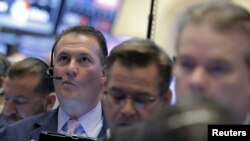The major U.S. indices have soared since the February 11 low and are now trading just below all-time highs. The catalysts have been a cautious Federal Reserve and easy monetary policy, as well as companies beating estimates on low expectations.
With earnings reports about halfway concluded, 76 percent of companies have beaten analyst estimates, well ahead of the historical average of 66 percent, according to S&P Global Market Intelligence.
Even though the Standard & Poor's 500 traded through the key 2100 level and touched 2111, the 2016 high, earlier in the week, it still could be a good time for investors who have been waiting on the sidelines to put money back into the market.
“I just don’t see a major sell-off in the cards as the S&P settles into a new range around 2080-2100,” said Mark Sebastian, chief operating officer of Option Pit in Chicago. “It makes some sense to start nibbling at stocks. Obviously, it would have been better to do back in March, but if we were to get three to four down days, I would step in, because I do not see a massive sell-off on the horizon.”
Crude oil traded higher for the third straight week as sentiment seems to have turned, despite record supply in the market. Perhaps this is a sign that oil supply has actually peaked and demand is now the story, according to Jason Bennett, co-head of International Global Projects at Baker Botts.
“At this price, I think the oil supply has probably peaked. There is plenty of spare production capacity that could be brought on-line, but there is also a fair amount of current production that is likely not economic at today’s prices,” Bennett said. “Those two effects likely offset one another going forward. That being said, the real story is demand — oil supply has plenty of room to grow as demand increases and prices respond.”
Currency markets were also active after the yen slid across the board, following the Bank of Japan’s decision to push interest rates below zero. The reduction will cause real interest rates to fall, with the goal of stimulating consumption and investment, Bank of Japan Governor Haruhiko Kuroda said in a news conference.
Trading week ahead
All trading, media and tech geek eyes will be on Apple, which will report earnings after the market closes Tuesday. Apple is perhaps the most widely anticipated report of every quarter because it is a good barometer for the tech space and consumer spending trends. It also affects other stocks that rely on Apple for revenue, like supply-chain companies Broadcom and Skyworks Solutions.
Analysts at Morgan Stanley are positive on Apple. In a research report, Katy Huberty said, “We believe Apple’s March quarter results to be near the high end of the guidance range, which has been the norm in recent quarters. In the last 10 quarters, Apple has exceeded the high end of its revenue guidance by 3 percent on average.” Huberty has an “outperform” rating on the stock and a $135 price target.
In addition to Apple, the earnings calendar is full with 186 S&P 500 companies slated to report, including Jetblue, Chipotle, AT&T, Twitter, Boeing, Facebook, ConocoPhillips, Amazon.com, Linkedin and Exxon Mobil.
Interest rate decision
Once again, the Federal Reserve takes center stage this week. The Federal Open Market Committee meeting starts on Tuesday and the interest rate policy decision will be delivered Wednesday at 2 p.m. EDT. As always, this is a market-moving event because easy monetary policy has been the underlying factor in moving equities higher.
While an interest rate hike is widely unexpected, headlines will make trade volatile immediately following the announcement. According to a Reuters poll, economists are holding firm to their expectations for a rate hike in June and then another by the end of this year.
Data to watch
There are some key economic data on tap, including reports on new home sales, durable goods, personal income and outlays, weekly jobless claims, and weekly crude oil and natural gas inventories. The main focus will be on gross domestic product, released Thursday morning.
GDP is the all-inclusive measure of economic activity. There are four major categories: personal consumption expenditures, investment, net exports and government. It helps the Federal Reserve and investors gauge the strength or weakness in consumer spending, business and residential investment, and inflation. Unemployment data and GDP are major factors the Fed considers when creating monetary policy.






